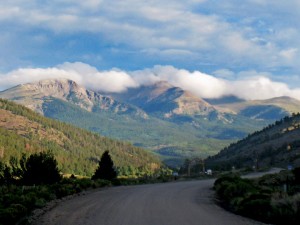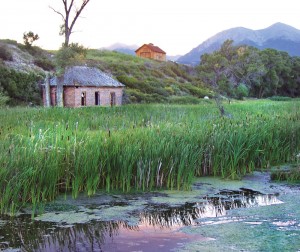By George Sibley
So far this wildfire season, we’ve been lucky in Central Colorado (knock on wood). There have been little fires here and there, but nothing like those that other parts of Colorado – and the Rocky Mountains in general – have been experiencing.
The ferocity of some of these fires has been compounded by their nearness to civilization. I am not referring to the uncivilized people who build out in what our late lamented founder called “the Stupid Zone,” remote places where people build big fancy homes and have the temerity to expect fire protection and affordable insurance. The fires this summer have roared right through the Stupid Zones and gone on to threaten whole communities. For example, the Waldo Canyon fire forced the evacuation of Manitou Springs. Whole suburbs were evacuated and some destroyed by that fire and the other big one in northern Colorado. Forest fires aren’t supposed to be a Main Street problem.
Why do we have wildfires? I spent some summers “down on the ground” with the Forest Service getting an up-close look at our forests when said forests were on fire. I was part of a “hotshot crew” based in Crested Butte – a couple dozen somewhat-trained wildfire-fighters supposedly ready to drop whatever we were doing and go fight a forest fire anywhere in the United States.
Our job was to put the fires out. But the more I did that work, the more I realized we were often doing something thoroughly counter-productive. The fires that we could actually put out were doing beneficial work for the forest, running around on the ground for the most part, burning off the litter of dead stuff that is rampant in most Temperate Zone forests. And our putting out those “clean-up” fires was leaving the forest more vulnerable to an inevitable day, in a dry summer like this, when a fire would be unleashed on the forest that we would not be able to put out. We experienced a few of those – I still have dreams about an afternoon when our whole crew had to run uphill to a clearing, to escape an uncontrolled and uncontrollable fire that suddenly seemed to be everywhere in an Idaho forest. A century of putting out all the little lightning-strike fires has left us with miles and miles of over-mature forest in monolithic stands, rather than the forest mosaics of different aged stands and clearings that occur when forests are left to lightning and nature. And thanks to another related but unintended human impact, beetles have killed most of those over-mature trees, leaving miles and miles of dead-standing trees, creating a potential fire problem that transcends all previous fire problems.
The belief that nature (or God if you prefer) is perfect and complete in all its systems looks a little shaky when one looks closely at the “carbon cycle” in the Temperate Zone. All life on earth, including us, is carbon-based – water-based too, of course, but it’s the carbon I want to look at here. Carbon-based life ages, wears out and dies, or gets killed by other life large or microscopic, and the dead stuff is decomposed, disassembled, into solids, liquids and gases, which all get taken up into new life – thus the carbon cycle. In other words, life, death, and the resurrection through rot.
But it is in that third phase of the cycle where the cycle does not work perfectly. Some living things die faster than the agents of decomposition can decompose them in the Temperate Zones of the planet. This is not the case with most of our animal parts, which agents of decay take care of pretty quickly except for bones and other hard parts – unless we seal ourselves in lead coffins, and thus take ourselves out of this only sure form of resurrection. It is also not true for plant and tree life in the tropical rainforests, where it is warm and wet enough for the resurrection through rot to take place fairly quickly.
But in the drier parts of the Temperate Zone – like our Rocky Mountain region – the forests are too cool and too dry for decomposition through rot to keep up with death, so there is a buildup of dry dead tree-stuff in the forests, and a measure of dynamic balance in the carbon cycle is only achieved through episodic rapid decomposition by fire. Fire is not such a careful decomposer as rot, and results in more oxidized carbon going into the atmosphere. What goes into the ground is black, not brown, but the products of fire, as of rot, are elemental building blocks for new life, and the new life usually comes quickly, at least in tree terms, except when a fire has been so hot, due to so much built-up fuel, that it literally bakes the earth. But in the cool dry mountain forests, fire is what keeps the carbon cycle close to a dynamic balance.
What is intriguing today, however, is looking at the carbon cycle in terms of a mega-long-term carbon balance – like 200 million years. Back then, in the period called “Carboniferous,” there had been such an explosion of carbon-based life on earth that the resurrection-through-rot phase was overwhelmed, and it was too wet most of the time for much fire. The backlog of dead plant and animal life got so far ahead of the resurrection phase that dead stuff got buried under more dead stuff, and more and more. Then, other stuff – sand, gravel, mud – washed or blew in and over it, burying it yet further, till the weight of overburden crushed and smushed it to highly concentrated carbon that was locked away from the forces of oxidation and decomposition.
But, having outgrown the carbon cycle’s production of fuel for our needs – we humans discovered these deposits of “banked” carbon, and for abut the past 200 years have been digging or pumping those deposits up and burning them at an increasingly amazing rate. Our whole way of life is based on burning that stored carbon. And so doing, we have been substantially increasing the amount of carbon in the carbon cycle – especially in the form of carbon gases in the atmosphere. But moving that amount of new carbon oxides into new life is now another piece of the cycle that is out of balance.
Can we truly believe that this is not making a difference in the quantity and quality of life here on earth? There are many who refuse to believe it, either because their religion demands that God’s creation be perfect, or because their ideology demands that Obama be wrong. But I do not see how anyone could look squarely at this situation and not think that putting this concentrated carbon back into the global carbon cycle must have an effect – especially from the carbon gases. We know through experimentation that those gases trap and absorb warm infrared radiation. We also know through careful measurement that the planet has been warming up through the measurement period. Whether there is causation here or just correlation seems like debating the number of angels on the head of a pin.
There are a couple ways to look at the probability of climate change from new carbon in the cycle. One is to look at it as a sort of a good thing in the long term: it may in fact bring an end to the Pleistocene, which has hardly nurtured life on earth. For the past two million years, most of Central Colorado has either been under ice or racked by the cold air flowing off of it. Humans were not here until the ice retreated 10,000-20,000 years ago. Could it be that the Ice Age is a long-term consequence of too much carbon having been removed from the global carbon cycle? And now we are putting some of that back. Reputable earth scientists have hypothesized that we are now extending the current interglacial period because of carbon we’re restoring to the carbon cycle, especially in the atmosphere. The Big Ice may not be back.
That possible long-term benefit noted, however, there are a lot of shorter-term negatives associated with the warming that most climate scientists associate with these human-induced changes in the carbon cycle. One big one for our forests has been the extent to which the warming trend of recent decades has made life very good for the beetle larvae that feed through the winter just under the bark on coniferous trees. It hasn’t been cold enough to kill the larvae, so the larvae have killed the trees. The amount of dead carboniferous matter in our forests today far exceeds the usual excess of dead stuff, creating the potential for fires “worse than the worst” experienced – which will of course put even more carbon gases into the atmosphere, increasing its capacity to hold even more heat.
We have been, and are, quite literally playing with fire, however unconsciously. And while a somewhat warmer planet over the long term might not be a terrible thing, it is certainly going to be disruptive in the short term, as our forests burn, our cities melt, and the corn belt moves to the Canadian steppe. Most scientists at this point no longer believe we can stop additional warming from happening, which means we had better wake up to the realities we are creating and plan our adaptive strategies. Like Whole-Earther, Stewart Brand, said fortysome years ago: “We are as gods and might as well get good at it.” At least good enough to survive our own acts.
George Sibley was born in Western Pennsylvania, but was conceived in Colorado by Colorado natives, and thus considers himself to be a native Coloradan.


